Hamm J, Cao Y, Belkin M. Learning privately from multiparty data[C]//International Conference on Machine Learning. 2016: 555-563.
Abstract
在多方场景下,怎样在不获取其他party’s private data的情况下,通过组合本地训练的分类器,训练一个准确的符合DP的分类模型?本文提出了
transfer the ‘knowledge’ of the local classifier ensemble by first creating labeled data from auxiliary unlabeled data, and then train a global $\epsilon$-differentially private classifier.
本文指出大部分的voting都太敏感,因此提出了新的risk weighted by class probabilities estimated from the ensemble。相对于非隐私的方案,误差控制在$O(\epsilon^{-2} M^{-2})$之内,$M$是parties的数量。
Introduction
[1] 提出了通过平均local分类器的参数来得到global分类器,通过DP机制来防止平均参数时造成的隐私泄露。平均参数是一个简单并且实用的步骤,可以通过Yao提出的SMC来实现。但是,对于非数值型的参数,比如决策树或者聚合不同类型的分类器时,直接平均参数并不适用。
本文提出了通过两个步骤来组合local分类器为一个global分类器的方法:第一步,本地训练的分类器被一个信任的实体收集,但是直接使用DP处理过的参数并不实用,
Instead, we use the classifier ensemble to generates (pseudo)labels for auxiliary unlabeled data, thus transferring the knowledge of the ensemble to the auxiliary data.
第二步,用标记过的辅助数据找到一个empirical risk minimizer,然后通过output pertubation[2] 的方法release一个DP的分类器。
当用ensemble of classifiers为辅助数据生成label时,最简单的方法就是majority voting。本文量化的表明了这种训练方式对于local分类器的vote是highly sensitive的(是说对于差分隐私敏感度高吗?)。这样一来会造成很大的性能损失。所以本文提出新的risk insensitive to individual votes,每个采样根据ensemble的confidence来分配权重。
One of our main results is in Theorem 4: we can achieve $\epsilon$-differential privacy with a generalization error of $O(\epsilon^{-2} M^{−2})$ and $O(N^{−1})$ terms, relative to the expected risk of a non-private solution, where M is the number of parties and N is the number of samples in auxiliary data. This result is especially useful in a scenario where there are a large number of parties with weak local classifiers such as a group of connected smart devices with limited computing capability.
本文的三个优点:
- flexible: 可以组合不同类型的local分类器
- 误差收敛快
- provides $\epsilon$-differential privacy to all samples of a party and not just a single sample.
Preliminary
直接用[2]中的对参数加噪声的方式,不同点是:
One important difference of our setting to previous work is that we consider $\epsilon$-differential privacy of all samples of a party, which is much stronger than $\epsilon$-differential privacy of a single sample.
然后提了一些假设,类似于[2]中的:
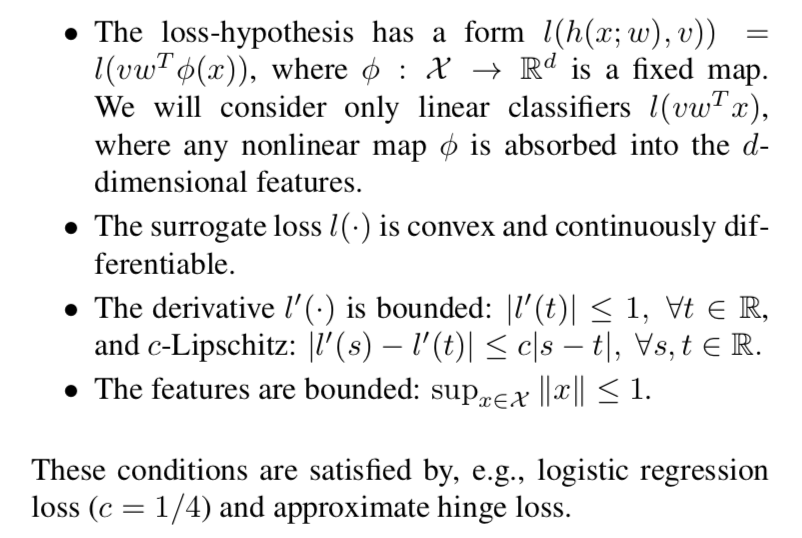
Transferring knowledge of ensemble
Local classifiers
假设local分类器是M个黑盒(可以是不同类型的分类器),每个分类器通过本地的训练集训练,数据是独立同分布的。切分数据通过sample without replacement [3]。
Privacy issues of direct release
第一步中,local分类器被一个可信任的实体收集。最简单的方法就是在DP处理后直接释放所有M个分类器参数。但是这种操作需要一个恒定的敏感度(sensitivity),不如直接释放统计数据的平均值,这样敏感度为$O(M^{-1})$。此外有效的DP机制只能用在特定类型的分类器上[4]。
另一种方法是,将ensemble当成一种服务来对test data进行预测。如果用majority voting来为测试样本做预测,Report Noisy Max[5] 可以被用来sanitize the votes for a single query。但是当查询次数变多时,noise是和查询次数线性成比例的,这在现实中很不实用。
Leveraging auxiliary data
为了解决上述问题,提出transfer the knowledge of the ensemble to a global classifier using auxiliary unlabeled data。具体地,利用ensemble来为辅助数据生成标签,然后再用来训练global分类器。辅助数据的数量不影响privacy (就因为没有标签就可以不影响privacy吗?),反而数据量越大,分类器越接近于原始的ensemble,bound是$O(N^{-1})$。和用ensemble预测对比,the sanitized global classifier可以被用来任意多的查询次数,而不影响privacy。
Finding a global private classifier
First attempt: ERM with majority voting
利用M个local分类器的majority voting来生成辅助数据。就是超过半数的分类器对当前数据的预测标签作为该数据的标签。
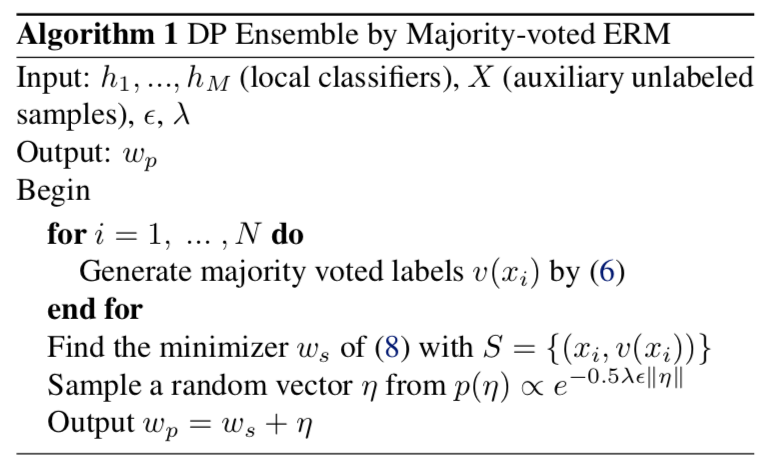
如图算法1表示了这种方法。公式6就是majority voting。公式8是ERM的损失函数
\[R_{S}^{\lambda} (w) = \frac{1}{N} \sum_{(x,v \in S)} l(h(x;w),v) + \frac{\lambda}{2} \Vert w \Vert ^2 \tag{8}\](后边还列了一下这个式子有和没有正则项的期望,这不是纯凑吗?还没看到用得着的地方啊。。)
Theorem 1. The perturbed output $w_p = w_s + \eta$ from Algorithm 1 with $p(\eta) \propto e^{-\frac{\lambda \epsilon}{2} \Vert \eta \Vert}$ is $\epsilon$-differentially private.
Proof. Suppose $D = (S^{(1)}, \dots, S^{(M)})$ 是M个训练集,$D’ = (S’^{(1)}, \dots, S^{(M)})$是相邻的数据集,通过$D$和$D’$计算出相应的local分类器$H = (h_1, \dots, h_M)$和$H’ = (h’1, \dots, h_M)$。通过投票生成相应的辅助数据$S = {x_i, v(x_i)}$和$S’ = {x_i, v’(x_i)}$,同样的features但是可能不同的labels。$R_S^{\lambda} (w)$和$R{S’}^{\lambda} (w)$分别是基于$S$和$S’$的regularized empirical risks。$w_s$和$w_{s’}$是对应risk的minimizer。根据[2]的推论7和8可以得出
\[\Vert w_s - w_{s'} \Vert \leq \frac{1}{\lambda} \max _w \Vert \nabla g(w) \Vert,\]其中,$g(w)$ is the risk difference $R_S^{\lambda} (w) - R_{S’}^{\lambda} (w)$,本文中
\[\Vert \nabla g(w) \Vert \leq \frac{1}{N} \sum_{i=1}^{N} \Vert v(x_i) x_i l'(v(x_i) w^T x_i) - v'(x_i) x_i l'(v'(x_i) w^T x_i) \Vert\] \[\leq \frac{1}{N} \sum_{i=1}^{N} \Vert x_i \Vert \times \vert l'(w^Tx_i) + l'(-w^Tx_i) \vert . \tag{*}\]注意到假设了$\Vert x \Vert \leq 1 \text{ and } \vert l’(\cdot) \vert \leq 1$。最坏的情况是每个$v(x_i)$和$v’(x_i)$都不相同,因此the RHS of $*$ is bounded by 2. 因此,$w_s$的$L_2$ sensitivity是
\[\max_{S,S'} \Vert w_s - w_{s'} \Vert \leq \frac{2}{\lambda}\]因此得证。
Performance issues of majority voting
分析majority-voted ERM的误差。主要被两部分bound,添加的noise和risk的期望与实际的差距。majority-voted ERM的敏感度是$\frac{2}{\lambda}$,而标准的ERM是$\frac{2}{N \lambda}$,对应的误差bound是
\[R(w_p) \leq R(w_0) + O(\epsilon^{-2}) + O(N^{-1})\]with high probability。但是如果$\epsilon$很小的时候,constant gap $O(\epsilon^{-2})$会很大,不能保证successful learning。引起这个的原因是multiparty voting的最坏结果:假设投票的$M-1$个打平(M是奇数),那么敏感度的最坏情况就是,剩下的那个local分类器是相反的,这样辅助数据所有的标签都是相反的,最终得到的global分类器是完全不同的。
Better yet: weighted ERM with soft labels
设$\alpha(x)$是$M$个分类器中把sample $x$分成正例的比例,引入weighted loss:
\[l^{\alpha} (\cdot) = \alpha(x) l(w^T x) + (1-\alpha(x)) l(-w^Tx)\]这样一来,如果$M$个votes全是正的或者负的,则此时的loss和original loss是一样的;而当正负预测正好相等时,loss也不会像之前的那种对单个vote那么敏感。特别地,
a single vote can change $l^{\alpha}(\cdot)$ only by a factor of $\frac{1}{M}$.
Lemma 2. For any $w$, the expection of the weighted loss is asymptotically the expection of the unweighted loss:
\[\lim_{M \rightarrow \infty} E_x[l^{\alpha}(w)] = E_{x,v}[l(w^Txv)]\]
Lemma 2表明weighted loss的期望和标准loss的期望是渐进相等的,when the target v is a probabilistic concept from $P(h(x) = v)$ of the random hypothesis, as opposed to a deterministic concept $v(x)$ from majority voting.
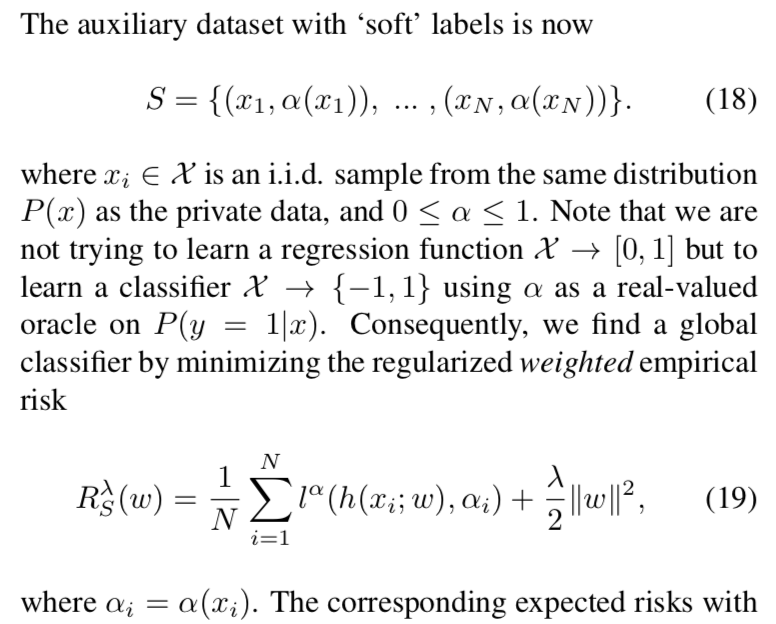
然后仍然用output perturbation来学习满足DP的分类器。如算法2所示。
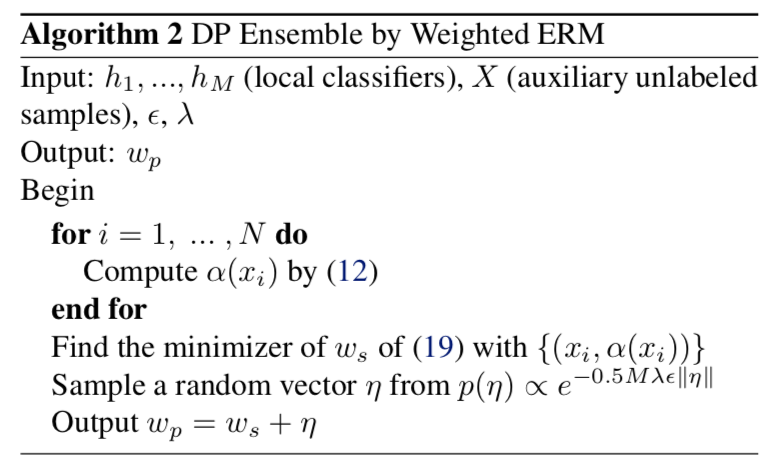
Privacy and performance
Theorem 3. The perturbed output $w_p = w_s + \eta$ from Algorithm 2 with $p(\eta) \propto e^{-\frac{M \lambda \epsilon}{2} \Vert \eta \Vert}$ is $\epsilon$-differentially private.
这样,只需要$1/M$的噪声量就可以达到同样的DP。
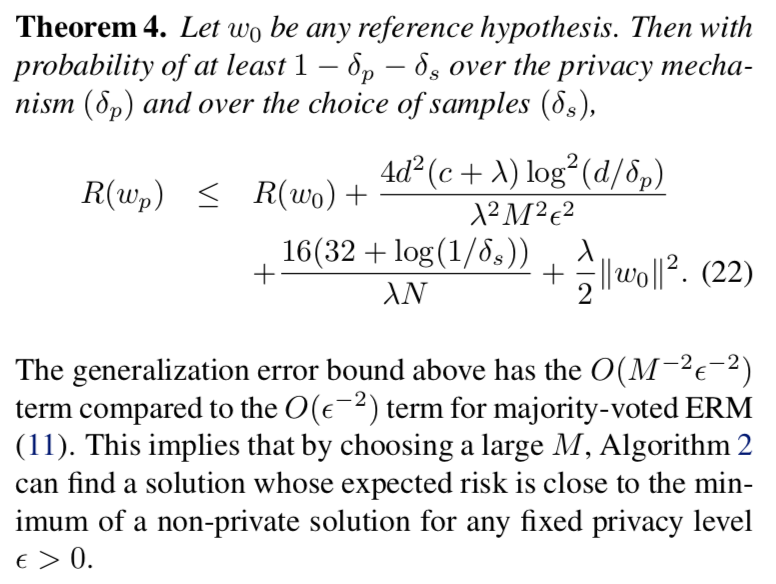
Related work
Parameter averaging through SMC[1]. Private exchange of gradient information to minimize empirical risks incrementally[6,7]. 本文motivated by[1],但是用了和[1]完全不同的方法来aggregate local classifiers.
We use an ensemble approach and average the classifier decisions[8] instead of parameters, which makes our approach applicable to arbitrary and mixed classifier types.
注记一下:所谓ensemble就是直接放一起呗:${h_1,h_2,\cdots,h_M}$,所以可以有不同的类型,主要用来对unlabled data进行voting呗。以半监督的方式[4,9]。
Experiments
用了三组数据:活动识别、网络入侵检测、恶意URL检测。对比了算法1,2和[1]中的parameter averaging,以及单个local分类器,和non-private的global分类器。算法1效果挺一般,算法2比[1]中的方法强。
Reference
[1] Pathak, Manas, Rane, Shantanu, and Raj, Bhiksha. Multiparty differential privacy via aggregation of locally trained classifiers. In Advances in Neural Information Processing Systems, pp. 1876–1884, 2010.
[2] Chaudhuri, Kamalika, Monteleoni, Claire, and Sarwate, Anand D. Differentially private empirical risk minimization. The Journal of Machine Learning Research, 12:1069–1109, 2011.
[3] Politis, D. N., Romano, J. P., and Wolf, M. Subsampling. Springer Verlag, 1999.
[4] Ji, Zhanglong, Jiang, Xiaoqian, Wang, Shuang, Xiong, Li, and Ohno-Machado, Lucila. Differentially private distributed logistic regression using private and public data. BMC medical genomics, 7(Suppl 1):S14, 2014.
[5] Dwork, Cynthia and Roth, Aaron. The algorithmic foundations of differential privacy. Theoretical Computer Science, 9(3-4): 211–407, 2013.
[6] Rajkumar, Arun and Agarwal, Shivani. A differentially private stochastic gradient descent algorithm for multiparty classification. In International Conference on Artificial Intelligence and Statistics, pp. 933–941, 2012.
[7] Hamm, Jihun, Champion, Adam, Chen, Guoxing, Belkin, Mikhail, and Xuan, Dong. Crowd-ML: A privacy-preserving learning framework for a crowd of smart devices. In Proceedings of the 35th IEEE International Conference on Distributed Computing Systems (ICDCS). IEEE, 2015.
[8] Breiman, Leo. Bagging predictors. Machine learning, 24(2):123–140, 1996a.
[9] Jagannathan, Geetha, Monteleoni, Claire, and Pillaipakkamnatt, Krishnan. A semi-supervised learning approach to differential privacy. In Data Mining Workshops (ICDMW), 2013 IEEE 13th International Conference on, pp. 841–848. IEEE, 2013.
